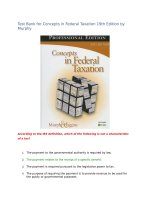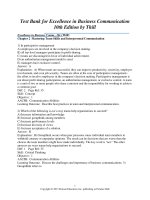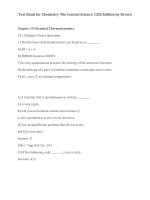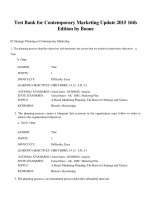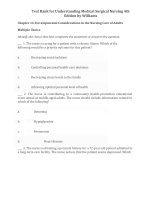Download test bank for skills in clinical nursing 8th edition by berman
Bạn đang xem bản rút gọn của tài liệu. Xem và tải ngay bản đầy đủ của tài liệu tại đây (229.03 KB, 37 trang )
Test Bank for Skills in Clinical
Nursing 8th Edition by Berman
Link download full: />Berman/Snyder, Test Bank for Skills in Clinical Nursing 8th
Edition Chapter 6
Question 1
Type: MCSA
The nurse is caring for a client who is on bed rest with bathroom privileges. While
the client is in the bathroom, the nurse changes the client’s bed and makes the bed
in what way?
1. Unoccupied open bed
2. Occupied open bed
3. Unoccupied closed bed
4. Surgical bed
Correct Answer: 1
Rationale 1: The bed is unoccupied, and the nurse would make an open bed, with the
top sheets folded back, so the bed is ready for the client to return to. An occupied bed
would be used if the client were unable to get out of bed. A closed bed is made with
the top covers over the entire bed to keep the bed clean when not in use. A surgical
bed would be made using extra materials in preparation for the
returning postoperative client.
Rationale 2: The bed is unoccupied, and the nurse would make an open bed, with
the top sheets folded back, so the bed is ready for the client to return to. An
occupied bed would be used if the client were unable to get out of bed. A closed
bed is made with the top covers over the entire bed to keep the bed clean when
not in use. A surgical bed would be made using extra materials in preparation for
the returning postoperative client.
Rationale 3: The bed is unoccupied, and the nurse would make an open bed, with
the top sheets folded back, so the bed is ready for the client to return to. An
occupied bed would be used if the client were unable to get out of bed. A closed
bed is made with the top covers over the entire bed to keep the bed clean when
not in use. A surgical bed would be made using extra materials in preparation for
the returning postoperative client.
Rationale 4: The bed is unoccupied, and the nurse would make an open bed, with
the top sheets folded back, so the bed is ready for the client to return to. An
occupied bed would be used if the client were unable to get out of bed. A closed
bed is made with the top covers over the entire bed to keep the bed clean when
not in use. A surgical bed would be made using extra materials in preparation for
the returning postoperative client.
Global Rationale: The bed is unoccupied, and the nurse would make an open bed,
with the top sheets folded back, so the bed is ready for the client to return to. An
occupied bed would be used if the client were unable to get out of bed. A closed bed
is made with the top covers over the entire bed to keep the bed clean when not
in use. A surgical bed would be made using extra materials in preparation for the
returning postoperative client.
Cognitive Level: Applying
Client Need: Physiological Integrity
Client Need Sub: Basic Care and Comfort
QSEN Competencies: II.B.3. Base individualized care plan on client values,
clinical expertise, and evidence
AACN Essential Competencies: III.1. Explain the interrelationships among
theory, practice, and research
NLN Competencies: Knowledge and Science: Relationships between
knowledge/science and quality and safe client care Nursing/Integrated
Concepts: Nursing Process: Implementation Learning Outcome: Define
the key terms used in the skill of bed-making. Page Number: pp. 200201
Question 2
Type: MCSA
The nurse is caring for a client in shock, and places the bed at an angle with the
head lower than the feet. Which term will the nurse use when documenting this
position in the medical record?
1. Reverse Trendelenburg position
2. Trendelenburg position
3. Fowler’s position
4. Semi-Fowler’s position
Correct Answer: 2
Rationale 1: The Trendelenburg position is used to place the head lower than
the feet to improve blood flow to the brain. Reverse Trendelenburg places the
bed straight but at an angle that puts the feet lower than the head. Fowler’s
position raises the head of the bed into a 90° angle so the client is sitting
upright. Semi-Fowler’s raises the head of the bed approximately 45° so the
client’s head is upright at a reclining angle.
Rationale 2: The Trendelenburg position is used to place the head lower than
the feet to improve blood flow to the brain. Reverse Trendelenburg places the
bed straight but at an angle that puts the feet lower than the head. Fowler’s
position raises the head of the bed into a 90° angle so the client is sitting
upright. Semi-Fowler’s raises the head of the bed approximately 45° so the
client’s head is upright at a reclining angle.
Rationale 3: The Trendelenburg position is used to place the head lower than the
feet to improve blood flow to the brain. Reverse Trendelenburg places the bed
straight but at an angle that puts the feet lower than the head. Fowler’s position
raises the head of the bed into a 90° angle so the client is sitting upright. SemiFowler’s raises the head of the bed approximately 45° so the client’s head is
upright at a reclining angle.
Rationale 4: The Trendelenburg position is used to place the head lower than the
feet to improve blood flow to the brain. Reverse Trendelenburg places the bed
straight but at an angle that puts the feet lower than the head. Fowler’s position
raises the head of the bed into a 90° angle so the client is sitting upright. SemiFowler’s raises the head of the bed approximately 45° so the client’s head is
upright at a reclining angle.
Global Rationale: The Trendelenburg position is used to place the head lower
than the feet to improve blood flow to the brain. Reverse Trendelenburg places the
bed straight but at an angle that puts the feet lower than the head. Fowler’s position
raises the head of the bed into a 90° angle so the client is sitting upright. SemiFowler’s raises the head of the bed approximately 45° so the client’s head is
upright at a reclining angle.
Cognitive Level: Applying
Client Need: Physiological Integrity
Client Need Sub: Basic Care and Comfort
QSEN Competencies: II.B.3. Base individualized care plan on client
values, clinical expertise, and evidence
AACN Essential Competencies: III.1. Explain the interrelationships among
theory, practice, and research
NLN Competencies: Knowledge and Science: Relationships between
knowledge/science and quality and safe client care Nursing/Integrated
Concepts: Nursing Process: Implementation Learning Outcome: Define
the key terms used in the skill of bed-making. Page Number: p. 198
Question 3
Type: MCSA
Which nursing action is inappropriate when providing the client with a hygienic
and comfortable environment? 1. Speaking softly in the hall of the facility
2. Obtaining a bed extender for the client who is very tall
3. Placing a room deodorizer in the room of the client with asthma
who complains of the odor in the room
4. Maintaining room temperature between 68°
F and 74°
F
Correct Answer: 3
Rationale 1: Deodorizers might be contraindicated for the client with
respiratory disorders. All of the other activities are supportive of the client’s
environmental needs.
Rationale 2: Deodorizers might be contraindicated for the client with
respiratory disorders. All of the other activities are supportive of the client’s
environmental needs.
Rationale 3: Deodorizers might be contraindicated for the client with
respiratory disorders. All of the other activities are supportive of the client’s
environmental needs.
Rationale 4: Deodorizers might be contraindicated for the client with
respiratory disorders. All of the other activities are supportive of the client’s
environmental needs.
Global Rationale: Deodorizers might be contraindicated for the client with
respiratory disorders. All of the other activities are supportive of the client’s
environmental needs.
Cognitive Level: Applying
Client Need: Physiological Integrity
Client Need Sub: Basic Care and Comfort
QSEN Competencies: I.B.3. Provide client-centered care with sensitivity and
respect for the diversity of human experience
AACN Essential Competencies: IX.3. Implement holistic, client-centered care that
reflects an understanding of human growth and development, pathophysiology,
pharmacology, medical management, and nursing management
across the health-illness continuum, across life span, and in all health care
settings NLN Competencies: Knowledge and Science: Relationships between
knowledge/science and quality and safe client care
Nursing/Integrated Concepts: Nursing Process: Implementation
Learning Outcome: Describe the elements to consider when providing
clients with a hygienic and comfortable environment. Page Number: p. 197
Question 4
Type: MCSA
The nurse caring for an older adult client diagnosed with dementia bathes the client
and changes the wound dressing. Prior to leaving the room, which action by the
nurse is the most appropriate?
1. Raise the side rails.
2. Place the head of the bed in the semi-Fowler’s position.
3. Place the bed in the low position.
4. Remove the footboard from the bed.
Correct Answer: 3
Rationale 1: The nurse should return the bed to the low position to prevent injury to
the client if he attempts to get out of bed autonomously. Side rails are generally
contraindicated with most clients suffering from dementia because of the risk for
injury if they attempt to crawl over the rail. The position of the bed would be
determined by the time of day, activities the client will be performing, and client
preference. There would be no reason to remove the footboard from the bed.
Rationale 2: The nurse should return the bed to the low position to prevent injury to
the client if he attempts to get out of bed autonomously. Side rails are generally
contraindicated with most clients suffering from dementia because of the risk for
injury if they attempt to crawl over the rail. The position of the bed would be
determined by the time of day, activities the client will be performing, and client
preference. There would be no reason to remove the footboard from the bed.
Rationale 3: The nurse should return the bed to the low position to prevent injury to
the client if he attempts to get out of bed autonomously. Side rails are generally
contraindicated with most clients suffering from dementia because of the risk for
injury if they attempt to crawl over the rail. The position of the bed would be
determined by the time of day, activities the client will be performing, and client
preference. There would be no reason to remove the footboard from the bed.
Rationale 4: The nurse should return the bed to the low position to prevent injury
to the client if he attempts to get out of bed autonomously. Side rails are generally
contraindicated with most clients suffering from dementia because of the risk for
injury if they attempt to crawl over the rail. The position of the bed would be
determined by the time of day, activities the client will be performing, and client
preference. There would be no reason to remove the footboard from the bed.
Global Rationale: The nurse should return the bed to the low position to prevent
injury to the client if he attempts to get out of bed autonomously. Side rails are
generally contraindicated with most clients suffering from dementia because of
the risk for injury if they attempt to crawl over the rail. The position of the bed
would be determined by the time of day, activities the client will be performing,
and client preference. There would be no reason to remove the footboard from the
bed. Cognitive Level: Applying
Client Need: Safe and Effective Care Environment
Client Need Sub: Safety and Infection Control
QSEN Competencies: I.B.3. Provide client-centered care with sensitivity and
respect for the diversity of human experience
AACN Essential Competencies: IX.3. Implement holistic, client-centered care that
reflects an understanding of human growth and development, pathophysiology,
pharmacology, medical management, and nursing management across the healthillness continuum, across life span, and in all health care settings
NLN Competencies: Knowledge and Science: Relationships between
knowledge/science and quality and safe client care Nursing/Integrated Concepts:
Nursing Process: Implementation
Learning Outcome: Describe the elements to consider when providing
clients with a hygienic and comfortable environment. Page Number: p. 199
Question 5
Type: MCSA
The nurse is caring for a client in respiratory distress. Which bed position is
the most appropriate for this client?
1. Semi-Fowler’s position
2. Trendelenburg position
3. Flat position
4. Fowler’s position
Correct Answer: 4
Rationale 1: The client with respiratory distress will breathe more easily if the bed
is placed in the Fowler’s position, because it reduces the compression of the
abdominal contents into the stomach and allows for full lung expansion. SemiFowler’s position is the best choice if Fowler’s position is not possible due to
the client’s condition, but is not as good as Fowler’s because it still allows some
intrusion of abdominal contents into the diaphragm and limits full excursion.
Trendelenburg position would be contraindicated because this causes abdominal
organs to press into the diaphragm. Flat is also contraindicated, and will
increase the client’s respiratory distress.
Rationale 2: The client with respiratory distress will breathe more easily if the bed
is placed in the Fowler’s position, because it reduces the compression of the
abdominal contents into the stomach and allows for full lung expansion. SemiFowler’s position is the best choice if Fowler’s position is not possible due to the
client’s condition, but is not as good as Fowler’s because it still allows some
intrusion of abdominal contents into the diaphragm and limits full excursion.
Trendelenburg position would be contraindicated because this causes abdominal
organs to press into the diaphragm. Flat is also contraindicated, and will
increase the client’s respiratory distress.
Rationale 3: The client with respiratory distress will breathe more easily if the bed
is placed in the Fowler’s position, because it reduces the compression of the
abdominal contents into the stomach and allows for full lung expansion. SemiFowler’s position is the best choice if Fowler’s position is not possible due to the
client’s condition, but is not as good as Fowler’s because it still allows some
intrusion of abdominal contents into the diaphragm and limits full excursion.
Trendelenburg position would be contraindicated because this causes abdominal
organs to press into the diaphragm. Flat is also contraindicated, and will increase
the client’s respiratory distress.
Rationale 4: The client with respiratory distress will breathe more easily if the bed
is placed in the Fowler’s position, because it reduces the compression of the
abdominal contents into the stomach and allows for full lung expansion. SemiFowler’s position is the best choice if Fowler’s position is not possible due to
the client’s condition, but is not as good as Fowler’s because it still allows some
intrusion of abdominal contents into the diaphragm and limits full excursion.
Trendelenburg position would be contraindicated because this causes abdominal
organs to press into the diaphragm. Flat is also contraindicated, and will increase
the client’s respiratory distress.
Global Rationale: The client with respiratory distress will breathe more easily if
the bed is placed in the Fowler’s position, because it reduces the compression of
the abdominal contents into the stomach and allows for full lung expansion. SemiFowler’s position is the best choice if Fowler’s position is not possible due to the
client’s condition, but is not as good as Fowler’s because it still allows some
intrusion of abdominal contents into the diaphragm and limits full excursion.
Trendelenburg position would be contraindicated because this causes abdominal
organs to press into the diaphragm. Flat is also contraindicated, and will increase
the client’s respiratory distress.
Cognitive Level: Analyzing
Client Need: Physiological Integrity
Client Need Sub: Reduction of Risk Potential QSEN Competencies: II.B.3.
Base individualized care plan on client values,
clinical expertise, and evidence
AACN Essential Competencies: III.1. Explain the interrelationships among
theory, practice, and research
NLN Competencies: Knowledge and Science: Relationships
between knowledge/science and quality and safe client care
Nursing/Integrated Concepts: Nursing Process: Implementation
Learning Outcome: Identify indications for common bed positions.
Page Number: p. 198
Question 6
Type: MCSA
The nurse caring for a client with a fractured third cervical vertebrae
determines the client is in spinal shock. Which bed position is the most
appropriate for this client?
1. Flat
2. Semi-Fowler’s
3. Trendelenburg
4. Reverse Trendelenburg
Correct Answer: 1
Rationale 1: A client with a fractured cervical vertebra must be maintained in a flat
position to prevent any movement of the neck. Placing the client into the
Trendelenburg position, which would normally be indicated for a client in shock,
would put this client at risk for further damage to the spinal cord. Semi-Fowler’s
position is contraindicated due to the client’s spinal injury, and the reverse
Trendelenburg position is contraindicated due to the client’s diagnosis of spinal
shock. Rationale 2: A client with a fractured cervical vertebra must be
maintained in a
flat position to prevent any movement of the neck. Placing the client into the
Trendelenburg position, which would normally be indicated for a client in
shock, would put this client at risk for further damage to the spinal cord. SemiFowler’s position is contraindicated due to the client’s spinal injury, and the
reverse Trendelenburg position is contraindicated due to the client’s diagnosis of
spinal shock.
Rationale 3: A client with a fractured cervical vertebra must be maintained in a
flat position to prevent any movement of the neck. Placing the client into the
Trendelenburg position, which would normally be indicated for a client in
shock, would put this client at risk for further damage to the spinal cord. SemiFowler’s position is contraindicated due to the client’s spinal injury, and the
reverse Trendelenburg position is contraindicated due to the client’s diagnosis of
spinal shock.
Rationale 4: A client with a fractured cervical vertebra must be maintained in a
flat position to prevent any movement of the neck. Placing the client into the
Trendelenburg position, which would normally be indicated for a client in
shock, would put this client at risk for further damage to the spinal cord. SemiFowler’s position is contraindicated due to the client’s spinal injury, and the
reverse Trendelenburg position is contraindicated due to the client’s diagnosis of
spinal shock.
Global Rationale: A client with a fractured cervical vertebra must be maintained
in a flat position to prevent any movement of the neck. Placing the client into the
Trendelenburg position, which would normally be indicated for a client in
shock, would put this client at risk for further damage to the spinal cord. SemiFowler’s position is contraindicated due to the client’s spinal injury, and the
reverse Trendelenburg position is contraindicated due to the client’s diagnosis of
spinal shock.
Cognitive Level: Analyzing
Client Need: Physiological Integrity
Client Need Sub: Reduction of Risk Potential
QSEN Competencies: II.B.3. Base individualized care plan on client values,
clinical expertise, and evidence AACN Essential Competencies: III.1. Explain the
interrelationships among
theory, practice, and research
NLN Competencies: Knowledge and Science: Relationships
between knowledge/science and quality and safe client care
Nursing/Integrated Concepts: Nursing Process: Implementation
Learning Outcome: Identify indications for common bed positions.
Page Number: p. 198
Question 7
Type: MCSA
The nurse delegates bed making to the unlicensed assistive personnel (UAP).
Which client’s bed should be made by the nurse and not the UAP?
1. The postoperative client diagnosed with dementia on complete bed rest
2. The client who is diagnosed with myocardial infarction who has
bathroom privileges
3. The client with increased intracranial pressure on complete bed rest
4. The postoperative client
Correct Answer: 3
Rationale 1: The client with increased intracranial pressure will generally have an
increase in pressure with any activity or movement, so the nurse should change this
client’s bed, although the unlicensed assistive personnel could assist the nurse. The
other clients’ beds could be safely delegated to the unlicensed assistive personnel.
Rationale 2: The client with increased intracranial pressure will generally have an
increase in pressure with any activity or movement, so the nurse should change this
client’s bed, although the unlicensed assistive personnel could assist the nurse. The
other clients’ beds could be safely delegated to the unlicensed assistive personnel.
Rationale 3: The client with increased intracranial pressure will generally have an
increase in pressure with any activity or movement, so the nurse should change this
client’s bed, although the unlicensed assistive personnel could assist the nurse. The
other clients’ beds could be safely delegated to the unlicensed assistive personnel.
Rationale 4: The client with increased intracranial pressure will generally have an
increase in pressure with any activity or movement, so the nurse should change this
client’s bed, although the unlicensed assistive personnel could assist the nurse. The
other clients’ beds could be safely delegated to the unlicensed assistive personnel.
Global Rationale: The client with increased intracranial pressure will generally
have an increase in pressure with any activity or movement, so the nurse should
change this client’s bed, although the unlicensed assistive personnel could assist
the nurse. The other clients’ beds could be safely delegated to the unlicensed
assistive personnel.
Cognitive Level: Analyzing
Client Need: Safe and Effective Care Environment
Client Need Sub: Management of Care
QSEN Competencies: II.A.2. Describe scopes of practice and roles of health care
team members
ACN Essential Competencies: IX.14. Demonstrate clinical judgment and
accountability for client outcomes when delegating to and supervising other
members of the health care team
NLN Competencies: Teamwork: Manage delegation effectively.
Nursing/Integrated Concepts: Nursing Process: Planning
Learning Outcome: Recognize when it is appropriate to delegate bed-making to
unlicensed assistive personnel.
Page Number: p. 201
Question 8 Type: MCMA
When delegating bed-making to the unlicensed assistive personnel (UAP), the
nurse would instruct the UAP on which items? Standard Text: Select all that
apply.
1. Proper disposal of linens that contain drainage
2. What tubes or dressings the client might have
3. How to make hospital corners
4. Whom to inform if they notice anything unusual
5. Placing the call bell in a specific location for a client with mobility
concerns Correct Answer: 1,2,5
Rationale 1: The nurse should instruct the UAP on how to dispose of linens that
contain drainage, and should inform the UAP of any tubes or dressings the client
may have in place and the importance of placing the call bell in a specific location
for a client with mobility concerns. The nurse should not have to teach the UAP
how to make a bed, because the UAP should be familiar with the procedure. There
is no need to inform the UAP whom to notify because the UAP should inform the
nurse if anything unusual occurs.
Rationale 2: The nurse should instruct the UAP on how to dispose of linens that
contain drainage, and should inform the UAP of any tubes or dressings the client
may have in place and the importance of placing the call bell in a specific location
for a client with mobility concerns. The nurse should not have to teach the UAP
how to make a bed, because the UAP should be familiar with the procedure. There
is no need to inform the UAP whom to notify because the UAP should inform the
nurse if anything unusual occurs.
Rationale 3: The nurse should instruct the UAP on how to dispose of linens that
contain drainage, and should inform the UAP of any tubes or dressings the client
may have in place and the importance of placing the call bell in a specific location
for a client with mobility concerns. The nurse should not have to teach the UAP
how to make a bed, because the UAP should be familiar with the procedure. There
is no need to inform the UAP whom to notify because the UAP should inform the
nurse if anything unusual occurs.
Rationale 4: The nurse should instruct the UAP on how to dispose of linens that
contain drainage, and should inform the UAP of any tubes or dressings the client
may have in place and the importance of placing the call bell in a specific location
for a client with mobility concerns. The nurse should not have to teach the UAP
how to make a bed, because the UAP should be familiar with the procedure. There
is no need to inform the UAP whom to notify because the UAP should inform the
nurse if anything unusual occurs.
Rationale 5: The nurse should instruct the UAP on how to dispose of linens that
contain drainage, and should inform the UAP of any tubes or dressings the client
may have in place and the importance of placing the call bell in a specific location
for a client with mobility concerns. The nurse should not have to teach the UAP
how to make a bed, because the UAP should be familiar with the procedure. There
is no need to inform the UAP whom to notify because the UAP should inform the
nurse if anything unusual occurs.
Global Rationale: The nurse should instruct the UAP on how to dispose of linens that
contain drainage, and should inform the UAP of any tubes or dressings the client may
have in place and the importance of placing the call bell in a specific location for a
client with mobility concerns. The nurse should not have to teach the UAP how to
make a bed, because the UAP should be familiar with the procedure.
There is no need to inform the UAP whom to notify because the UAP
should inform the nurse if anything unusual occurs. Cognitive Level:
Applying
Client Need: Safe and Effective Care Environment
Client Need Sub: Management of Care
QSEN Competencies: II.A.2. Describe scopes of practice and roles of health care
team members
ACN Essential Competencies: IX.14. Demonstrate clinical judgment and
accountability for client outcomes when delegating to and supervising other
members of the health care team
NLN Competencies: Teamwork: Manage delegation effectively.
Nursing/Integrated Concepts: Nursing Process: Implementation
Learning Outcome: Recognize when it is appropriate to delegate bed-making to
unlicensed assistive personnel. Page Number: pp. 201-204, 205-206
Question 9
Type: MCMA
The nurse is making beds on the medical–surgical unit. What would the nurse
do differently when making a surgical bed versus an open unoccupied bed?
Standard Text: Select all that apply.
1. Strip the bed.
2. Do not tuck, miter, or toe-pleat the top covers.
3. Fold top sheets into a triangle at the side of the bed.
4. Place pillows on the chair beside the bed.
5. Raise the bed to a comfortable working
height. Correct Answer: 2,3,4
Rationale 1: When making a surgical bed, the top covers would not be tucked,
mitered, or pleated, but rather folded to the side of the bed, forming a triangle, so
the bed is prepared for the client to slide from the stretcher to the bed. Pillows are
removed from the bed and placed in the chair at the side of the bed because they
will be in the way when the client is transferred from the stretcher. The bed should
always be raised to a comfortable working height to avoid back strain for the
nurse when making a bed, and the old linen should be stripped prior to making the
fresh bed.
Rationale 2: When making a surgical bed, the top covers would not be tucked,
mitered, or pleated, but rather folded to the side of the bed, forming a triangle, so
the bed is prepared for the client to slide from the stretcher to the bed. Pillows are
removed from the bed and placed in the chair at the side of the bed because they
will be in the way when the client is transferred from the stretcher. The bed should
always be raised to a comfortable working height to avoid back strain for the
nurse when making a bed, and the old linen should be stripped prior to making the
fresh bed.
Rationale 3: When making a surgical bed, the top covers would not be tucked,
mitered, or pleated, but rather folded to the side of the bed, forming a triangle so the
bed is prepared for the client to slide from the stretcher to the bed. Pillows are
removed from the bed and placed in the chair at the side of the bed because they
will be in the way when the client is transferred from the stretcher. The bed should
always be raised to a comfortable working height to avoid back strain for the
nurse when making a bed, and the old linen should be stripped prior to making the
fresh bed.
Rationale 4: When making a surgical bed, the top covers would not be tucked,
mitered, or pleated, but rather folded to the side of the bed, forming a triangle, so
the bed is prepared for the client to slide from the stretcher to the bed. Pillows are
removed from the bed and placed in the chair at the side of the bed because they
will be in the way when the client is transferred from the stretcher. The bed should
always be raised to a comfortable working height to avoid back strain for the
nurse when making a bed, and the old linen should be stripped prior to making the
fresh bed.
Rationale 5: When making a surgical bed, the top covers would not be tucked,
mitered, or pleated, but rather folded to the side of the bed, forming a triangle, so
the bed is prepared for the client to slide from the stretcher to the bed. Pillows are
removed from the bed and placed in the chair at the side of the bed because they
will be in the way when the client is transferred from the stretcher. The bed should
always be raised to a comfortable working height to avoid back strain for the
nurse when making a bed, and the old linen should be stripped prior to making the
fresh bed.
Global Rationale: When making a surgical bed, the top covers would not be tucked,
mitered, or pleated, but rather folded to the side of the bed, forming a triangle, so
the bed is prepared for the client to slide from the stretcher to the bed.
Pillows are removed from the bed and placed in the chair at the side of the bed
because they will be in the way when the client is transferred from the stretcher.
The bed should always be raised to a comfortable working height to avoid back
strain for the nurse when making a bed, and the old linen should be stripped prior
to making the fresh bed.
Cognitive Level: Applying
Client Need: Physiological Integrity
Client Need Sub: Basic Care and Comfort QSEN Competencies: III.A.5.
Explain the role of evidence in determining best
clinical practice
AACN Essential Competencies: IX.8. Implement evidence-based nursing
interventions as appropriate for managing the acute and chronic care of clients
and promoting health across the life span
NLN Competencies: Quality and Safety: Current best practices
Nursing/Integrated Concepts: Nursing Process: Implementation
Learning Outcome: Verbalize the steps used in making:
1. A closed and open unoccupied bed.
2. A surgical bed.
3. An occupied bed.
Page Number: p. 204
Question 10
Type: SEQ
The nurse is making an occupied bed for a client who is required to maintain
complete bed rest. Place the steps of making an occupied bed in the
appropriate order to be performed.
Standard Text: Click on the down arrow for each response in the right
column and select the correct choice from the list.
Response 1. Loosen the bottom soiled linens behind the side-lying client and
fan-fold them close to the client.
Response 2. Pull linens from the center of the bed and make that side of the bed.
Response 3. Make the side of the bed behind the client and tuck sheets under the
client. Response 4. Position the client supine and place the clean top linen on
the bed.
Response 5. Remove the soiled linen from the bed.
Correct Answer: 1,3,5,2,4
Rationale 1: The nurse removes the top bedding, and may cover the client with the
top sheet or a bath blanket. Raise the side rail on the side the client will roll toward,
help the client roll, and then loosen the lower linen on the side behind the client.
Fan-fold soiled linen toward the client, apply fresh linen, and tuck under the
mattress, fan-folding the clean linen toward the center of the bed. Pull the side rail
up on that side of the bed and assist the client to roll over the linen in the center of
the bed. Move to the other side of the bed, lowering the side rail, and remove the
soiled linen. Once the soiled linen is removed, the fresh linen can be pulled over the
bed and tucked under the mattress. The client now can be positioned supine,
and fresh top sheets can be applied, removing the bath blanket or sheet
covering the client by pulling it out from under the clean top linen. Position the
client for comfort, place the bed in the low position, and make sure the call bell
is conveniently located.
Rationale 2: The nurse removes the top bedding, and may cover the client with the
top sheet or a bath blanket. Raise the side rail on the side the client will roll toward,
help the client roll, and then loosen the lower linen on the side behind the client.
Fan-fold soiled linen toward the client, apply fresh linen, and tuck under the
mattress, fan-folding the clean linen toward the center of the bed. Pull the side
rail up on that side of the bed and assist the client to roll over the linen in the
center of the bed. Move to the other side of the bed, lowering the side rail, and
remove the soiled linen. Once the soiled linen is removed, the fresh linen can be
pulled over the bed and tucked under the mattress. The client now can be
positioned supine, and fresh top sheets can be applied, removing the bath blanket
or sheet covering the client by pulling it out from under the clean top linen.
Position the client for comfort, place the bed in the low position, and make sure
the call bell is conveniently located.
Rationale 3: The nurse removes the top bedding, and may cover the client with the
top sheet or a bath blanket. Raise the side rail on the side the client will roll toward,
help the client roll, and then loosen the lower linen on the side behind the client.
Fan-fold soiled linen toward the client, apply fresh linen, and tuck under the
mattress, fan-folding the clean linen toward the center of the bed. Pull the side rail
